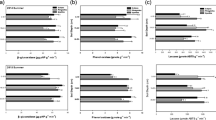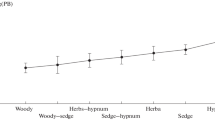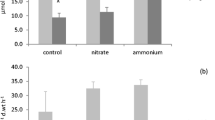Abstract
The aim of this study was to assess the structure of the microbial loop in a Sphagnum fallax — Carex rostrata fen of the French Massif central, and the impact of nitrogen supplies on the different microbial communities.
Microalgae (46% of the total microbial biomass), Protozoa (26%) and heterotrophic Bacteria (17%) were the dominant microorganisms. Rotifera (5%), Cyanobacteria (3%), Fungi (2%) and Nematoda (<1%) were also present. Testate Amoebae were well represented in Sphagnum peatland (14% of total microbial biomass). Thus, the structure of the protist community in the surface of fen peatlands is notably different from that recorded in other environments.
The input of nitrogen led to a steady increase in microbial biomasses, but only changed the structure of microbial communities significantly when the input was 50 kg ha-1. At high inputs, nitrogen supply increased the relative importance of Cyanobacteria, Euglenophyceae, Bacillariophyceae and Ciliates, and decreased the relative importance of heterotrophic Bacteria, other microalgae and testate Amoebae. The increase in the values of photosynthetic assimilation and heterotrophic activities could also reflect changes in community functioning.
Similar content being viewed by others
References
Aerts, R., B. Wallén & N. Malmer, 1992. Growthlimiting nutrients in Sphagnum dominated bogs subject to low and high atmospheric nitrogen supply. J. Ecol. 80: 131–140.
Amblard, C., G. Bourdier, T. SimeNgando, S. Rachiq & J. F. Carrias, 1994. Diel and vertical variations of the microbial stocks (Bacteria, heterotrophic Flagellates, Ciliates, phytoplankton) and their relative activities. Arch. Hydrobiol. Beih. 41: 125–144.
Amblard, C., J. F. Carrias, G. Bourdier & N. Maurin, 1995. The microbial loop in a humic lake: seasonal and vertical variations in the structure of the different communities. Hydrobiologia 300/301: 71–84.
Austin, K. A. & R. K. Wieder, 1987. Effects of elevated H+, SO42-, NO3 -, and NH4 + in simulated acid precipitation on the growth and chlorophyll content of 3 North American Sphagnum species. The Bryologist 90: 221–229.
Azam, F. & O. HolmHansen, 1973. Use of tritiated substrates in the study of heterotrophic in sea water. Mar. Biol. 23: 191–196.
Azam, F., T. Fenchel, J. G. Field, J. S. Gray, L. A. Meyer & F. Thingstad, 1983. The ecological role of water column microbes in the sea. Mar. Ecol. Pro. Ser. 10: 257–263.
Collins, V. G., B. T. D'sylva & P. M. Latter, 1978. Microbial population in peat. In Heal Ow. & D. F. Perkings (eds), Production Ecology of British Moors and Montane Grasslands, SpringerVerlag, Berlin: 94–112.
Couteaux, M. M. & M. Pussard M., 1982. Nature du régime alimentaire des protozoaires du sol. News Trends in Soil Biology. Proceedings of the VIII. Intl Colloquium of soil Zoology. Louvain-la-Neuve, Belgium: 179–195.
Czeczuga, B., 1993. Aquatic fungi of the Gorbacz and Ostrowki Peatbogs. Acta Mycologica 28: 69–75.
Duthie, H. C., 1965. A study of the distribution and periodicity of some algae in a bog pool. J. Ecol. 53: 343–359.
Francez, A. J., 1987. Successions écologiques dans les tourbiéres: le peuplement de rotiféresdu lactourbiére de Chambedaze (PuydeDôme, France). Bull. Ecol. 18: 31–38.
Francez, A. J., 1988. Le peuplement de rotiféres libres de deux lacstourbiéres du PuydeDôme (France). Vie et Milieu 38: 281–292.
Francez, A. J., 1992. Croissance et production primaire des sphaignes dans une tourbiére des monts du Forez (PuydeDôme, France). Vie Milieu 42: 21–34.
Fenchel, T., 1987. Ecology of protozoa. Science Tech. Publishers, Madison, Wisconsin/Springer Verlag, NewYork, 197 pp.
Gifford, D. J., 1991. The ProtozoanMetazoan trophic link in pelagicecosystems. J. Protozool. 38: 81–86.
Gilbert, D., C. Amblard, G. Bourdier & A. J. Francez, 1998. The microbial loop at the surface of a peatland: structure, functioning and impact of nutrients inputs. Microb. Ecol. 35: 83–93.
Groliére, C. A., 1977. Contribution à l'étude des ciliés des sphaignes: IIdynamique des populations. Protistologica 13: 335–352.
McKinley, K. R., 1977. Lightmediated uptake of 3H-glucose in a small hardwater lake. Ecology 58: 1356–1365.
McKinley, K. R. & R. G. Wetzel, 1979. Photolithotrophy, photoheterotrophy and chemoheterotrophy: patterns of resource utilisation on an annual and diurnal basis whitin a pelagic microbial community. Microb. Ecol. 5: 1–15.
Munawar, M. & T. Weisse, 1989. Is the 'Microbial loop' an early warning indicators of anthropogenic stress? in Munawar, M., G. Dixon, C. I. Mayfield, T. Reynoldson & M. H. Sadar (eds), Environmental Bioassay Techniques and their applications. Hydrobiologia 188/189: 163–174.
Porter, K. G. & Y. S. Feig, 1980. The use of DAPI for identifying and counting aquatic microflora. Limnol. Oceanogr. 25: 943–948.
Porter, K. G., E. B. Sherr, B. F. Sherr, M. Pace & R. W. Sanders, 1985. Protozoa in planktonic food webs. J. Protozool. 32: 409–415.
Richardson, K. A. & G. F. Fogg, 1982. The role of dissolved organic material in the nutrition and survival of marine dinoflagellates. Phycologia 21: 17–26.
Riemann, B. & K. Christoffersen, 1993. Microbial trophodynamics in temperate lakes. Marine Microb. Food webs 7: 69–100.
S.C.O.R.-U.N.E.S.C.O., 1966. Determination of photosynthethic pigments in sea water. S.C.O.R.-U.N.E.S.C.O., 69 pp.
Simej, K. & V. Straskrabova, 1992. Bacterioplankton production and protozoan bacterivory in a mesotrophic reservoir. J. Plankton Res. 14: 773–787.
Steemann-Nielsen, E., 1952. The use of radioactivecarbon (14C) formeasuring organic production in the sea. J. Cons. Explor.Mer. 18: 117–140.
Steemann-Nielsen, E., 1977. The carbon-14 technique formeasuring organic production by plankton algae. A report of the present knowledge. Folia Limnol. Scand. 17: 45.
Tomaszewicz, G. H., 1994. Abundance and composition of the desmid flora in a series of peat pits, in relation to pH and some other habitat parameters. Biologia, Bratislava 49/4: 519–524.
Utermölh, H., 1958. Zur vervollkommnung der quantative phytoplanktonmethodik. Mitt. Int. Ver. Limnol. 9: 1–38.
VanBreemen, N., C. T. Driscoll & J. Mulder, 1984. Acidic deposition and internal proton sources in acidification of soils and waters. Nature 307: 599–604.
Warner, B., 1987. Abundance and diversity of testate amoeba (Rhizopoda, Testacea) in Sphagnum peatlands in southwestern Ontario, Canada. Arch. Protistenkd. 133: 173–180.
Williams, B. L. & G. P. Sparling, 1988. Microbial biomass carbon and readily mineralized nitrogen in peat and forest humus. Soil Biol Biochem 20: 579–581.
Williams, B. L., D. Silcock, A.-J. Francez, D. Gilbert, A. Buttler, P. Grosvernier., Y. Matthey, H. Vasander, J. Jauhiainen, A. Kajak, J. Petal & M. Ilomets, 1996. Impact of nitrogen deposition on the carbon balance in peatland ecosystems. EC Environment programme, 3rd Framework. Final report., 96 pp.
Yesmin, L., S. M. Gammack, L. J. Sanger & M. S. Cresser, 1995. Impact of atmospheric N deposition on inorganic-and organic-N outputs in water draining from peat. Sc. Total Envir. 166: 201–209.
Rights and permissions
About this article
Cite this article
Gilbert, D., Amblard, C., Bourdier, G. et al. Short-term effect of nitrogen enrichment on the microbial communities of a peatland. Hydrobiologia 373, 111–119 (1998). https://doi.org/10.1023/A:1017091926454
Issue Date:
DOI: https://doi.org/10.1023/A:1017091926454




